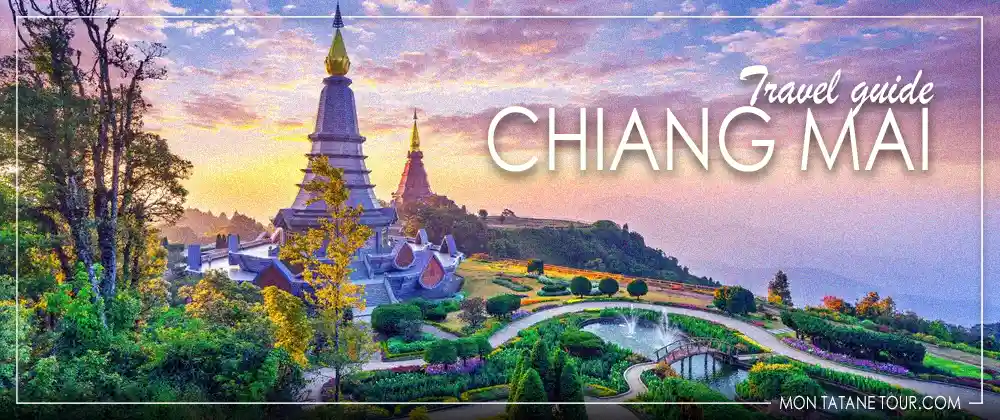Welcome to your MTT travel guide “Chiang Mai travel guide”

Chiang Mai travel guide
What to see and must-see places
Discover Chiang Mai like never before. From majestic temples to vibrant markets, immerse yourself in a city where history meets modernity. Explore the must-sees, from culinary experiences to wilderness adventures. Whether you’re looking for culture, relaxation or adventure, Chiang Mai promises unforgettable moments.
Wat Phra Singh
Explore the dazzling splendor of this Buddhist temple
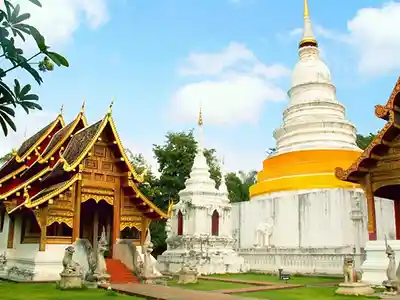
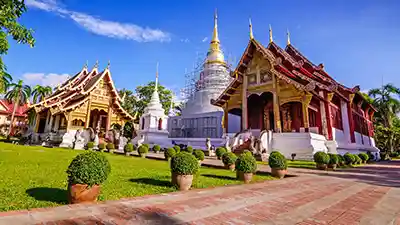
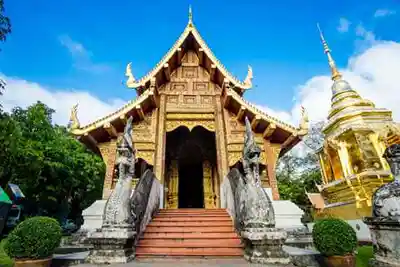
Wat Phra Singh is one of the most revered temples in Chiang Mai. This Buddhist temple, whose full name is Wat Phra Singh Woramahaviharn, is located in the heart of Chiang Mai’s old city.
- Religious Importance. Wat Phra Singh is famous for housing the sacred statue of Phra Buddha Singh, a highly respected Buddhist icon in Thailand. This temple is an important center of religious and cultural life in the region.
Highlights of the visit
- Magnificent architecture. Admire the temple’s traditional Thai architecture, with its pagoda-shaped roofs, gilded ornaments and detailed carvings. Particularly impressive is the Viharn Lai Kham, a prayer hall decorated with magnificent murals.
- Statue of Phra Buddha Singh. The statue of Phra Buddha Singh is the main attraction of the temple. Visitors come from far and wide to pay homage to this sacred image of the Buddha.
Useful information
- Access. Wat Phra Singh is located west of Chiang Mai’s old city, on Ratchadamnoen Road. You can easily reach it on foot from anywhere in the city.
- Opening hours. The temple is open daily from 6am to 5pm. Admission is generally free, but donations are appreciated for the temple’s upkeep.
Activities and extras
- Meditation. Participate in a guided meditation session for an immersive spiritual experience. Many temples in Chiang Mai offer meditation programs open to visitors.
- Songkran Festival. If you are visiting Chiang Mai in April, don’t miss the Songkran Festival, the Thai New Year. Wat Phra Singh is one of the centers of activity during this time, with processions and special ceremonies.
- Exploring the Old City. Take advantage of your visit to Wat Phra Singh to explore the surroundings of Chiang Mai’s Old City. Discover other temples, local markets and charming cafes.
Night market
Chiang Mai travel guide
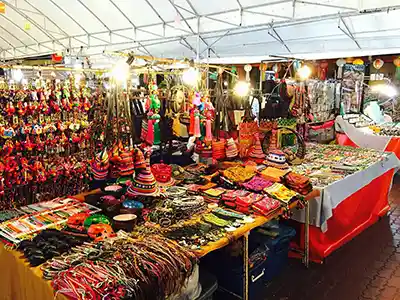
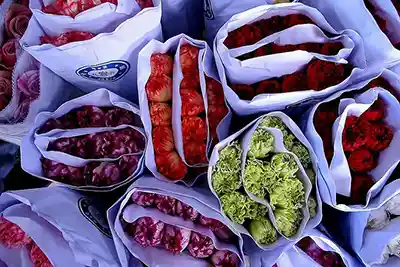
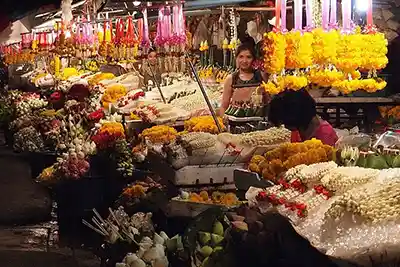
Chiang Mai Night Market, or Chiang Mai Night Bazaar, is an iconic attraction in the city. This historic market dates back several decades and is located in the heart of the city on Chang Klan Road.
- Local culture. The market offers a fascinating insight into Thai culture, with stalls selling a variety of local products, from handicrafts to clothing to street food.
Highlights of the visit
- Local Crafts. Discover a wide range of handcrafted products including handmade jewelry, wood carvings, textiles and unique souvenirs. This is the perfect place to buy authentic gifts and support local artisans.
- Thai Cuisine. Enjoy a variety of tasty street food. From pad thai and meat skewers to fresh fruits and traditional desserts, the market is a foodie’s paradise.
- Street performances. Enjoy the street performances that bring the market to life. Local musicians, dancers and street artists create a festive and dynamic atmosphere.
Useful information
- Access. Chiang Mai Night Market is located on Chang Klan Road, easily accessible.
- Opening hours. The market is open every evening from 6pm to midnight. Arrive early to avoid the crowds and enjoy a more relaxed experience.
- Currency. Most vendors accept Thai baht in cash. It is advisable to bring cash, as few stalls accept credit cards.
Activities and extras
- Cooking classes. Some stalls offer mini cooking classes where you can learn how to make traditional Thai dishes. This is a great way to take home a new and delicious skill.
- Thai Massages. Relax with a traditional Thai massage offered by the many massage parlors located around the market. After an evening of shopping, a massage is a great way to unwind.
- Negotiated Shopping. Practice your negotiation skills! Prices are often flexible, and haggling is part of the market experience. Be respectful and keep smiling, it’s a game for sellers as much as it is for buyers.
Wat Chedi Luang
Chiang Mai travel guide
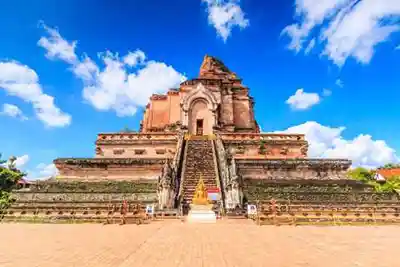
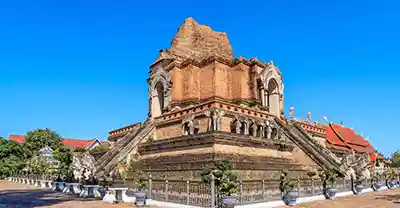
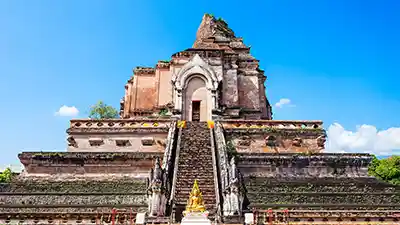
The name ‘Chedi Luang’ means ‘Temple of the Great Stupa’. The central chedi (stupa) once stood at an impressive 82 metres high before being partially destroyed by an earthquake in the 16th century.
Highlights of the visit
- Imposing Chedi. The central stupa, although damaged, remains an impressive structure. You can admire the ancient architecture and the giant guardian statues at its base.
- Emerald Buddha. Wat Chedi Luang once housed the famous Emerald Buddha, now located at Wat Phra Kaew in Bangkok. A replica of this sacred statue currently resides in the temple.
- The Tree Within the temple grounds you will find a huge sacred tree, which according to legend protects the city of Chiang Mai from natural disasters.
Useful information
- Access. Wat Chedi Luang is located in the heart of Chiang Mai’s old city, on Phrapokklao Road.
- Opening hours. The temple is open daily from 6am to 6pm. Admission is free, but donations are appreciated for the temple’s maintenance.
- Dress code. Respectful dress is required. Be sure to cover your shoulders and knees, and remove your shoes before entering buildings.
Why visit Wat Chedi Luang?
- Historical Heritage. Visiting Wat Chedi Luang allows you to delve into Chiang Mai’s rich history and admire unique centuries-old architecture.
- Spiritual Ambience. This temple offers a serene and spiritual atmosphere, ideal for meditation and reflection. You can also witness the chanting of Buddhist monks during ceremonies.
- Architectural beauty. The temple’s architecture and artistic details, including carvings and frescoes, are outstanding examples of Thai art and craftsmanship.
Doi Suthep
The sacred mountain of Chiang Mai
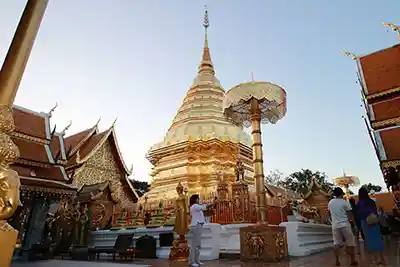
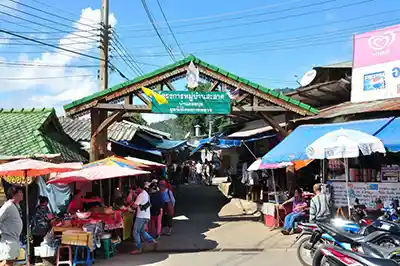

According to legend, a monk had a dream commanding him to find a relic of the Buddha. The relic, after several adventures, was placed on the back of a white elephant that stopped on Doi Suthep, marking the location for the construction of the temple.
Highlights of the visit
- Panoramic view. From the top of Doi Suthep, enjoy breathtaking views of Chiang Mai city and the surrounding valley. On a clear day, the view is spectacular and offers great photographic opportunities.
- Golden Chedi. The temple’s central golden stupa is an architectural masterpiece, glistening in the sun and housing Buddhist relics. Surrounded by golden bells and parasols, it is a symbol of the Buddhist faith in Thailand.
- Ornate Stairs. Climb the 306 steps of the staircase lined with naga (mythical serpents), or take a funicular to access the temple. The staircase itself is an attraction with its sculptures and artistic details.
Useful information
- Access. Doi Suthep is located about 15 kilometers from the center of Chiang Mai. You can reach it by taxi, songthaew (shared taxi) or scooter or take a tour. The journey offers picturesque views of the mountain road.
- Opening hours. The temple is open every day from 6am to 6pm. Entrance costs 1.40 euros (50 baths) for us foreigners, while Thais can enter for free (I find that normal).
Why visit Doi Suthep?
- Spirituality. Wat Phra That Doi Suthep is an important pilgrimage site for Buddhists and offers an enriching spiritual experience. Visitors can attend ceremonies and prayers by the monks.
- Cultural heritage. The temple is an exceptional example of Thai architecture and art, with detailed carvings, frescoes and decorative elements.
- Nature and tranquility. In addition to the architectural beauty, the temple is located in a beautiful natural setting, offering a peaceful atmosphere away from the hustle and bustle of the city.
Activities and extras
- Local Market. At the base of the mountain, explore the local market where you can buy souvenirs, Buddhist amulets, and taste local specialties.
- Night Tour. For a unique experience, visit Doi Suthep at dusk or sunrise. The view of the illuminated city of Chiang Mai is breathtaking.
- Doi Suthep-Pui National Park. Combine your visit with an exploration of Doi Suthep-Pui National Park, which offers hiking trails, waterfalls and botanical gardens.
Old town
Chiang Mai travel guide
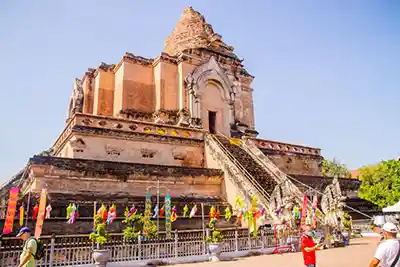

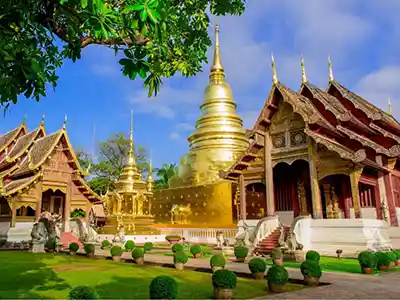
Welcome to the old town of Chiang Mai, a place full of charm and authenticity. Surrounded by historic ramparts, this part of the city is a journey through time, where every street corner holds fascinating discoveries.
Highlights of the visit
- Ancient Temples. The old city is full of magnificent temples, such as Wat Chedi Luang, Wat Phra Singh and Wat Chiang Man. Each of these temples has its own history and architectural features.
- Local Markets. Explore traditional markets like Warorot Market and Sunday Market, where you will find a variety of local produce, handicrafts and delicious food.
- Historic Architecture. Stroll through the narrow streets of the old town to admire traditional teak houses, colonial buildings and ancient walls that are a testament to Chiang Mai’s rich past.
Useful information
- Access. The old town is located in the centre of Chiang Mai and is easily accessible on foot, by bike, tuk-tuk or taxi. The area is compact, making it particularly pleasant to get around on foot.
- Opening hours. The old town is open and lively all year round, but markets and some sites have specific opening hours. It is advisable to check the opening hours of temples and markets before your visit.
- Dress code. When visiting temples, respectful dress is required. Cover your shoulders and knees, and remove your shoes before entering religious buildings.
Old city and temples – Guided walking tour Rate → 15 $
- Learn about the history of Chiang Mai from a local guide on a walking tour.
- Visit the impressive Wat Chedi Luang, home to Chiang Mai’s largest stupa.
- Admire the intricate wood-carved designs at Wat Phan Tao.
- Visit the sumptuous Wat Phra Singh and its mosaic-decorated sanctuary.
The White Temple (Wat Rong Khun) in Chiang Rai
Chiang Mai travel guide – An architectural marvel
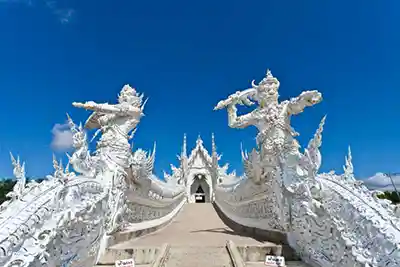
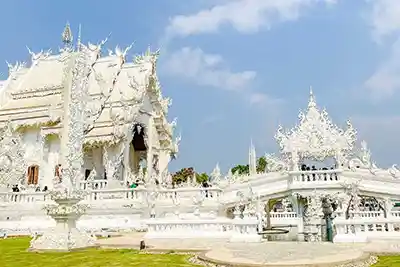
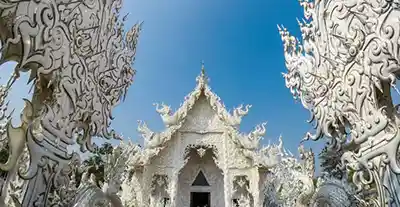
I would like to share with you a place that left a deep impression on me during my trip to Thailand. The White Temple, or Wat Rong Khun, in Chiang Rai, is a true artistic marvel, and I have no hesitation in considering it the most beautiful temple in the world.
- Symbolism. Unlike traditional temples, the White Temple is rich in contemporary Buddhist symbolism. Every detail of the architecture and decorations conveys messages about life, death and enlightenment.
Highlights of the visit
- Unique architecture. The temple is entirely white, symbolizing the purity of the Buddha. Thousands of fragments of inlaid mirrors shine in the sun, creating a dazzling and mystical effect.
- Bridge of Rebirth. Before entering the main temple, you will cross a bridge that represents the cycle of rebirth. The bridge is guarded by statues of demonic creatures, symbolizing the earthly desires that must be overcome to achieve enlightenment.
- Surprising interior. Unlike the exterior, the interior of the temple is decorated with modern frescoes depicting characters from popular culture and contemporary events. This aims to show the contrast between the spiritual world and the material world.
Useful information
- Access. Wat Rong Khun is located about 13 kilometers south of Chiang Rai and 3 hours from Chiang Mai. You can get there by taxi, tuk-tuk or local bus from the center of Chiang Rai. But I recommend the excursion below to be at ease if you leave from Chang Mai. Pick-up is in the main areas of downtown Chiang Mai.
- Opening hours. The temple is open daily from 8am to 5pm. It is advisable to arrive early to avoid the crowds and enjoy the tranquility of the site.
- Entrance. Entrance to the temple costs 100 baths (2.40 euros) for us tourists, free for Thais.
Why visit the White Temple?
- Art Experience. Wat Rong Khun is not only a place of worship, but also an open-air art gallery. Visitors can appreciate the talent and unique vision of artist Chalermchai Kositpipat.
- Unforgettable Photographs. With its dazzling architecture and intricate details, the White Temple is a favorite spot for photographers. Every angle offers a new perspective to capture.
- Spiritual Reflection. The temple offers a spiritual and introspective experience. Visitors are encouraged to reflect on the spiritual and philosophical messages conveyed through the artwork.
Activities and extras
- Chalermchai Art Gallery. Near the temple, visit the Chalermchai Kositpipat Art Gallery to see more of the artist’s work and learn about his inspiration and creative process.
- Souvenirs. At the entrance of the temple, small shops sell unique souvenirs related to the White Temple. This is a great place to buy authentic items to remember your visit.
- Donations and Participation. Visitors can make donations to support the continued construction of the temple and write their wishes on medallions hanging in the temple grounds.
From Chiang Mai – Guided tour of the temples of Chiang Rai. Rate → 51 $
- Admire the modern art and architecture of the iconic White Temple.
- Explore the Blue Temple, both lively and peaceful.
- Experience the spiritual ambiance of Wat Saengkaew Bodhiyan
- Last minute bookings are possible for the meeting place option.
- Explore responsibly with a GSTC certified tour
Doi Inthanon
Chiang Mai travel guide
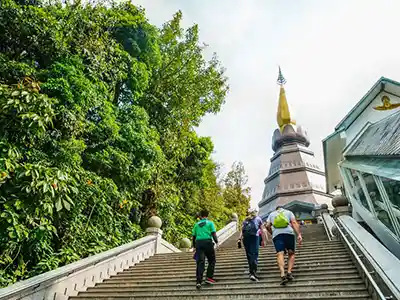
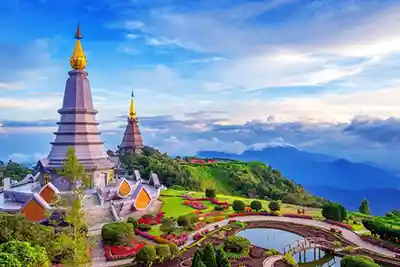
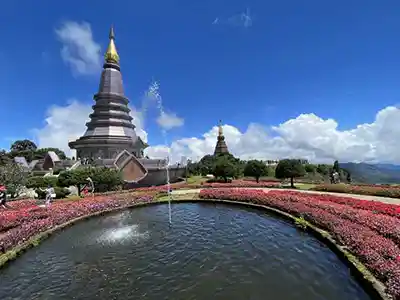
Prepare yourself for an extraordinary natural experience as you explore Doi Inthanon, the highest point in Thailand. Nestled in Doi Inthanon National Park, this peak offers a magnificent spectacle of the country’s natural beauty.
Highlights of the visit
- Panoramic view. From the top of Doi Inthanon, enjoy breathtaking views of the surrounding mountains and lush green valleys. On a clear day, the view stretches as far as the eye can see.
- Royal Pagodas. The two pagodas, Naphamethinidon and Naphaphonphumisiri, built in honour of King Bhumibol Adulyadej and Queen Sirikit, are iconic landmarks of the park. They are surrounded by beautiful flower gardens.
- Waterfalls. Doi Inthanon is home to several impressive waterfalls, including Mae Klang, Wachirathan and Siriphum waterfalls. Each waterfall offers unique beauty and ideal picnic areas.
Useful information
- Access. Doi Inthanon is located about 90 kilometers from Chiang Mai. You can reach it by car, taxi or organized tour. The journey takes about 1h30 to 2 hours.
- Opening hours. The park is open every day from 6 a.m. to 6 p.m.
- Entrance. Entrance to the national park costs around 300 baht for adults and 150 baht for children. Additional fees may apply for specific sites, such as the royal pagodas.
Why visit Doi Inthanon?
- Nature and landscapes. Doi Inthanon offers a total immersion in nature, with varied landscapes ranging from tropical forests to alpine meadows. Nature lovers will be enchanted by the biodiversity and natural beauty of the area.
- Outdoor Activities. The park offers many outdoor activities, such as hiking, bird watching and guided tours. The hiking trails are well marked and suitable for all levels.
- Culture and heritage. In addition to the natural wonders, Doi Inthanon is a place of cultural heritage. Local hill tribe villages, such as the Karen and Hmong, offer a glimpse into traditional life and local customs.
From Chiang Mai – Day trip to Doi Inthanon national park. Rate → 45 $
- Visit Doi Inthanon National Park on a fun day trip from Chiang Mai
- Discover the Karen tribes by visiting a local village.
- Walk on mountain trails, visit a waterfall and the highest point in Thailand.
- Explore responsibly with a GSTC certified tour.
Bua Thong waterfalls (sticky waterfalls)
Chiang Mai travel guide
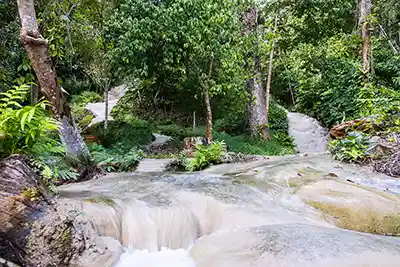
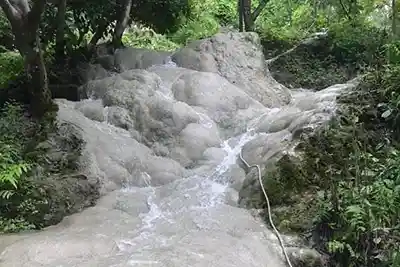
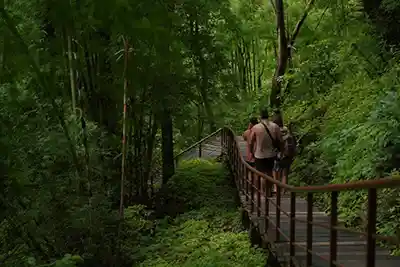
When you think of waterfalls, the image that often comes to mind is of powerful, thunderous waterfalls. However, the Bua Thong Waterfalls in Thailand offer you a completely unique experience. Nicknamed the “sticky waterfalls,” they offer you the chance to walk directly on water, an unforgettable adventure.
Highlights of the visit
- Unique experience. Unlike other waterfalls, Bua Thong offers a safe climbing experience thanks to the limestone texture of the rocks. This particularity makes the visit fun and accessible to everyone, even children.
- Untouched nature. Surrounded by lush green forests, the waterfalls are a haven of peace where you can relax and enjoy the natural beauty. The surrounding trails offer beautiful walks in the shade of the trees.
- Mineral Springs. Bua Thong Waterfalls are fed by natural mineral springs that flow from the rocks, creating clear and refreshing pools. These springs add an extra charm to the place.
Useful information
- Access. Bua Thong Waterfalls are located about 60 kilometers from Chiang Mai. You can reach it by car/taxi or by excursion from Chang Mai . The journey takes about 1h30.
- Opening hours. The waterfalls are open daily from 8am to 5pm. Arriving early allows you to enjoy the peace and quiet before other visitors arrive.
- Entrance. Access to the waterfalls is free if you get there by your own means.
Why visit Bua Thong Waterfalls?
- Adventure and fun. Sticky Waterfalls offers a unique adventure where you can climb the rocks while being refreshed by the water. It is a fun activity for families, couples and groups of friends.
- Natural Beauty. In addition to the climbing experience, the waterfalls are surrounded by lush forest, providing a peaceful and scenic setting. It is a perfect place to relax and connect with nature.
- Unforgettable photographs. The waterfalls offer many opportunities for taking memorable photos. The play of light on the limestone rocks and the crystal clear water create magnificent scenes.
From Chiang Mai, visit Doi Suthep temple and waterfall. Rate → 35 $
- Visit Wat Doi Suthep Temple with a Private Guide
- Receive a holy blessing and participate in a wrist bracelet tying ceremony
- Enjoy panoramic views of Chiang Mai
- Enjoy Bua Tong Waterfall
Giraffe women village (long neck Karen village)
Chiang Mai travel guide
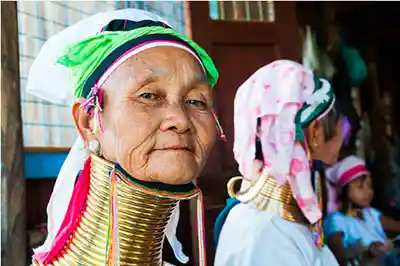
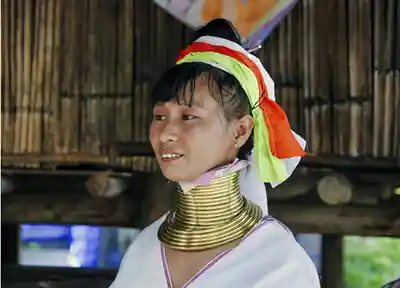
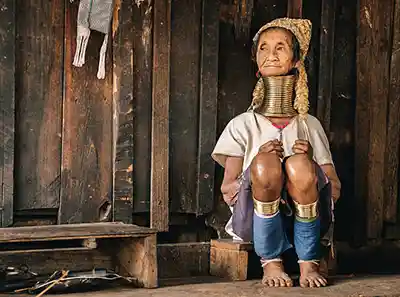
The Karen, also known as Karenni or Kayin, are an ethnic group native to Burma (Myanmar). Due to internal conflicts in their homeland, some Karen groups have migrated to Thailand, where they now live in villages such as the “Giraffe Women” village.
- Ring tradition. Women of the Padaung tribe, a sub-tribe of the Karen, are famous for wearing brass rings around their necks, which gives the appearance of an elongated neck. This tradition begins in childhood and the rings are added gradually over the years.
Highlights of the visit
- Unique culture. Visiting the village offers a rare opportunity to experience and understand the customs, culture and way of life of the Karen. The giraffe women are often happy to share their stories and the meaning of their traditions.
- Local Crafts. The village is known for its handicrafts, such as weavings and brass jewelry. You can see women weaving colorful textiles by hand and buy authentic souvenirs directly from the artisans.
- Photographs. The village’s colorful traditional costumes and picturesque landscapes provide plenty of opportunities for memorable photos.
Useful information
- Access. The Giraffe Women Village is located about 30 to 50 kilometers from Chiang Mai, depending on the specific village you visit. You can reach it by car, motorbike, taxi or organized tour. The journey takes about 1 to 2 hours.
- Opening hours. The village is generally open to visitors every day, from 8am to 5pm. It is best to arrive early to enjoy the peace and quiet and avoid the afternoon heat.
- Entrance. A small financial contribution may be requested to access the village. This fee helps support the community and preserve their traditions. It is super important and for us it is not a big deal.
Why visit the Giraffe Women Village?
- Cultural Immersion. A visit to the Giraffe Women Village is an opportunity to learn directly from the Karen people and appreciate their resilience and cultural richness.
- Support the community. By visiting and purchasing handicrafts, you are directly contributing to the economic well-being of the Karen community, helping to preserve their traditions and way of life.
- Historical Perspective. Understanding the challenges the Karen faced, including their migration and adaptation to life in Thailand, provides an important historical perspective on migration and ethnic conflict in Southeast Asia.
From Chang Mai – Chiang Rai 3 temples + Long Neck village. Rate → 54 $
- Day trip from Chiang Mai to Chiang Rai
- Visit to the White Temple
- Visit to Wat Rong Suea Ten (blue temple)
- Visit Wat Huay Pla Kang in Chiang Rai (Big Buddha of Chiang Rai)
- Visit long Neck village
→ See availability – Booking 👈
Tha Phae Gate
Chiang Mai travel guide
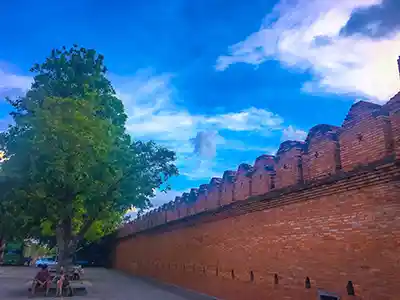
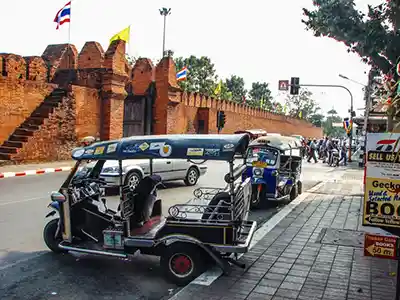
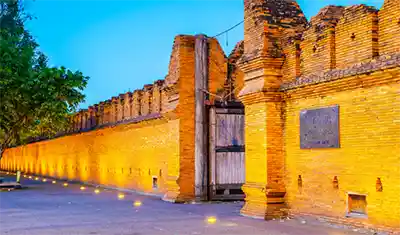
Tha Phae was the eastern gate of the city and served as the main access point for merchants and travelers coming from the east. It has great historical and cultural significance to Chiang Mai.
Highlights of the visit
- Architecture. The gate is an excellent example of traditional Lanna architecture. The red bricks and structures of the gate are a reminder of the rich heritage of the region.
- Cultural Activities. Tha Phae Gate is a gathering place for various cultural events and festivals, such as Yi Peng Festival (Lantern Festival) and Songkran (Thai New Year).
- Lively atmosphere. The area around Tha Phae Gate is always lively, with street performers, hawkers and musicians creating a vibrant atmosphere.
Useful information
- Access. Tha Phae Gate is located east of Chiang Mai’s old town, easily accessible by foot, bicycle or tuk-tuk. There are many hotels and hostels nearby, making access easy for visitors.
- Opening hours. The gate is accessible at any time, but it is particularly pleasant to visit early in the morning or at the end of the day to avoid the heat and take advantage of the soft light for photos.
- Entrance. Access to the gate and surrounding areas is free. Cultural activities and markets nearby are also free to access.
Activities and extras
- Local Markets. Near the gate, you will find the Sunday Walking Street Market, where you can buy souvenirs, taste local dishes and enjoy Thai handicrafts.
- Temple Tour. From Tha Phae Gate you can easily access some of Chiang Mai’s most famous temples, such as Wat Chedi Luang and Wat Phra Singh.
- Bike Tours. Rent a bike and explore the old town at your own pace. The small alleys and canals around the gate offer a pleasant and picturesque ride.
Benchmarks
- The City Walls. Take a stroll along the ancient city walls that still surround part of the old city. They offer an interesting view of Chiang Mai’s defensive history.
- Parks and green spaces. Right next to Tha Phae Gate, you will find green spaces where you can sit and relax, people-watch and enjoy the peaceful atmosphere.
- Cafes and restaurants. The area around Tha Phae Gate is full of cafes and restaurants.
Wat Umong Suan Puthatham
Chiang Mai travel guide
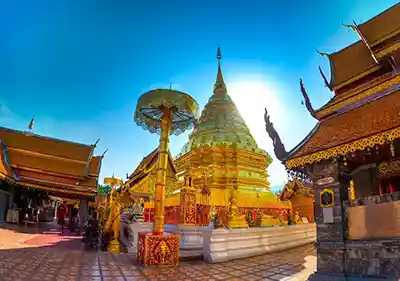
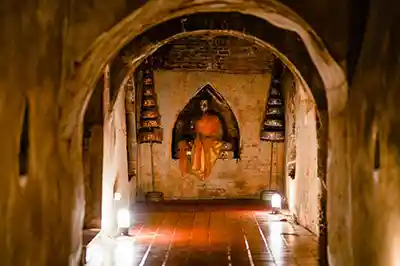
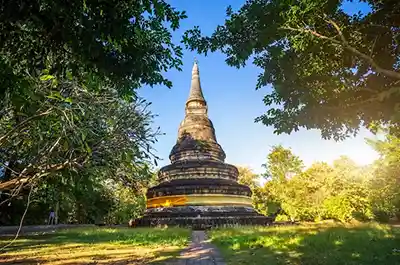
The temple is a center for meditation and spiritual retreat, offering visitors a serene atmosphere conducive to reflection and meditation. The name “Umong” means “tunnels,” referring to the underground passages that characterize this temple.
Highlights of the visit
- Mystical Tunnels. The tunnels of Wat Umong are a fascinating underground network where you can explore small shrines and niches containing Buddha statues. The walls of the tunnels are decorated with ancient frescoes and sacred inscriptions.
- Surrounding nature. Surrounded by dense forest, the temple offers a soothing natural setting. Visitors can stroll along shaded paths, discover ponds filled with fish and enjoy the tranquility of the place.
- Ancient relics. Wat Umong houses several historical relics, including an imposing stupa and fragments of ancient Buddhist sculptures. These relics offer insight into Chiang Mai’s religious history.
Useful information
- Access. Wat Umong is located about 4 kilometers west of Chiang Mai’s old city. You can reach it by taxi or bicycle. The journey from the city center takes about 15 to 20 minutes.
- Opening hours. The temple is open daily from 6am to 6pm.
- Entrance. Entrance to the temple is 20 baths.V
Why visit Wat Umong?
- Meditative experience. Wat Umong is an ideal place for those seeking tranquility and a spiritual experience. Visitors can participate in meditation sessions and attend Buddhist teachings.
- Unique Exploration. The tunnel network and underground sanctuaries offer a unique and mystical discovery experience, different from other temples in Chiang Mai.
- Natural Beauty. The temple’s forest setting allows visitors to reconnect with nature and enjoy a refreshing break from the hustle and bustle of the city.
Activities and extras
- Guided Meditation. Participate in guided meditation sessions led by resident monks. This is a great opportunity to learn Buddhist meditation techniques and find a moment of inner peace.
- Buddhist Library. Visit the temple library to learn more about Buddhism and explore a collection of sacred texts and spiritual books.
- Cafe and gift shop. Enjoy a cafe and gift shop on site. You can purchase religious items, books and souvenirs to remind you of your visit.
From Chiang Mai, visit Doi Suthep and Wat Umong in the evening. Rate → 20 euros
- Visit Wat Umong temple and explore the underground tunnels.
- Admire the sunset from the top of Doi Suthep mountain.
- Enjoy the night views of Chiang Mai city
→ See availability – Booking 👈

What to do in Chiang Mai?
Best things to do in Chiang Mai

Where to stay?
Chiang Mai travel guide – The best places to sleep



Chiang Mai is a bustling and diverse city with something to offer everyone. Here are five of the best neighborhoods to stay, based on your interests and budget:
The old town of Chiang Mai (old city)
It is the historic heart of the city, surrounded by a fortified wall. Here you will find numerous temples, bustling markets, shops, restaurants and accommodation options of all categories.
Nimmanhaemin (Nimman)
Nimman is a trendy neighborhood in Chiang Mai, known for its stylish boutiques, art galleries, trendy cafes and vibrant nightlife. It is an excellent choice for lovers of contemporary culture.
Riverside
This neighborhood runs along the Ping River and offers great water views. It is home to luxury hotels, riverside restaurants, night markets and easy access to the old town.
Hai Ya
Located south of the Old Town, Hai Ya is a peaceful neighborhood with a mix of affordable and mid-range accommodation options. It is close to many attractions and easily accessible.
Chang Moi
Just east of the Old Town, Chang Moi is a quiet residential area but close to the hustle and bustle of the city center. It offers an authentic local atmosphere and varied accommodation options.

Chiang Mai travel guide – Formalities for travelers



For travelers wishing to stay in Chiang Mai, here are 10 important points regarding formalities to take into account:
Valid passport: make sure your passport is valid for at least six months beyond your planned arrival date in Thailand.
Tourist visa: nationals of many European countries, including members of the European Union, can enter Thailand without a visa for tourist stays of up to 30 days by air. However, check current regulations before you leave, as policies may change.
Multiple entry visa : if you plan to stay more than 30 days or intend to leave and return to Thailand during your trip, you may need to obtain a multiple entry tourist visa before your departure.
Land visa waiver: the 30-day visa waiver is generally granted to travelers arriving by air. If you enter by land, the duration can be reduced to 15 days.
What documents to go to Chiang Mai
Proof of finances: it is advisable to have proof of sufficient financial means to cover your stay, although this may rarely be requested.
Return ticket: thai authorities may sometimes ask you to present a return or onward ticket to prove that you will be leaving the country at the end of your stay.
Travel Insurance: it is recommended to have travel insurance covering medical treatment in Thailand.
Visa extension: if you plan to extend your stay, you can apply for a visa extension at the local immigration office in Chiang Mai.
Respect local laws: respect local laws and regulations, including respect for the Thai monarchy, which is a sensitive subject.
Current entry requirements: check current entry requirements with the Thai embassy or Thai consulate in your country before traveling, as regulations and requirements may change.
Be sure to check official, up-to-date information on Thailand’s entry requirements before you go, as rules may vary depending on your nationality and recent regulatory changes.
Thai vocabulary for travelers
Chiang Mai travel guide – Learn a few words before my stay



Here are some useful words and phrases in Thai that will help you communicate with locals in Chiang Mai:
Greetings and courtesies
Sawasdee krap/ka (สวัสดีค่ะ/ครับ): Hello
Khop khun krap/ka (ขอบคุณค่ะ/ครับ): Thank you
Mai pen rai krap/ka (ไม่เป็นไรค่ะ/ครับ): You’re welcome
Sawasdee khap (สวัสดีค่ะ): Hello (for a woman)
Sawasdee krap (สวัสดีครับ): Hello (for a man)
Basic questions
Hao arai krap/ka (เป็นอย่างไรค่ะ/ครับ): How are you?
Khop khun krap/ka thuk krai (ขอบคุณค่ะ/ครับ ทุกที่): Thank you for everything
Khao rai krap/ka (ข้าวไรค่ะ/ครับ): What is it?
Hao thi na krap/ka (อยู่ที่ไหนค่ะ/ครับ): Where is it?
Hao rai krap/ka (เท่าไหร่ค่ะ/ครับ): How much does it cost?
Useful phrases for everyday life
Khao khao krap/ka (กินข้าวค่ะ/ครับ): I eat
Mai khao krap/ka (ไม่กินค่ะ/ครับ): I don’t eat
Khap krap/ka (ครับ/ค่ะ): Yes
Mai krap/ka (ไม่ค่ะ/ครับ): No
- Try to learn some basic Thai phrases before your trip. This will help you communicate with locals and find your way around the city.
- Don’t hesitate to ask locals for help. They are very welcoming and helpful.
- Be patient and respectful of Thai culture.

When to visit
Chiang Mai travel guide
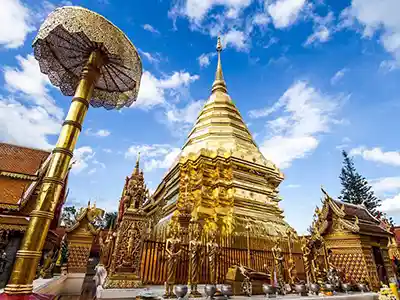

Deciding when to visit Chiang Mai depends on your personal preferences regarding weather, tourist crowds, and specific activities you would like to do. Here is a complete guide to help you optimize your trip depending on the season:
High season (november-april)
- November to February: This is the most pleasant time to visit Chiang Mai. Temperatures are mild, precipitation is rare, and the weather is generally sunny. It’s ideal for sightseeing, outdoor activities, and day trips.
- March and April: These months are also pleasant, although warmer. You can enjoy the sun, but it can be more crowded.
Low season (may-october)
- May to October: This is the rainy season, but it does not rain all the time. Precipitation is generally short and intense, followed by sunny periods. This time is ideal for travelers looking for lower fares and fewer tourists.
Shoulder season (april-may and september-october)
- April-May and September-October: These are transition periods between seasons. You can find great prices and enjoy decent weather. However, there may be some showers.
Special events
- Loy Krathong (November): It is an annual festival that celebrates the full moon in the month of November. People make flower boats and throw them into rivers and lakes.
- Songkran (April): Thai New Year is celebrated with water fights in the streets, making it a time of lively festivities.
- Chiang Mai Flower Festival (December): This festival celebrates the city’s flowering. The streets are decorated with flowers and there are parades and shows.
Tips to optimize your visit :
- Book your accommodations in advance if you are traveling during peak season, as hotels fill up quickly.
- If you prefer a quieter vacation and lower rates, consider visiting during the low season.
- Plan activities based on the weather. The months of November to February are perfect for sightseeing, while the rainy season is good for cultural activities and relaxation.
By choosing the season that best suits your preferences, you can optimize your trip to Chiang Mai and make the most of it.
Holidays in Thailand
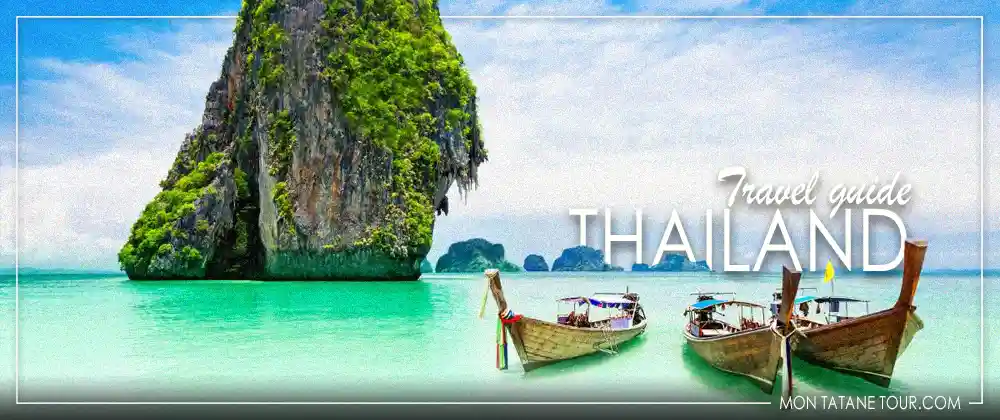
Want to visit other cities in Thailand?
MTT wishes you the most wonderful trip to Chiang Mai


